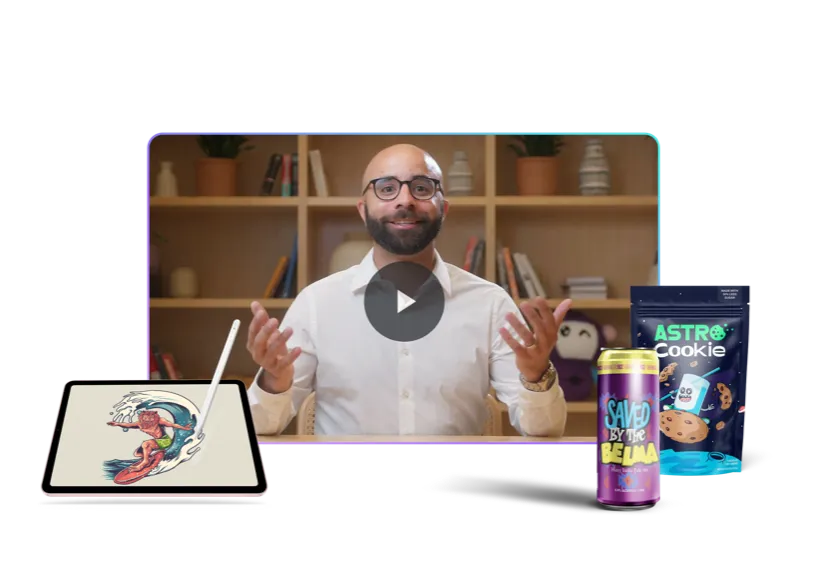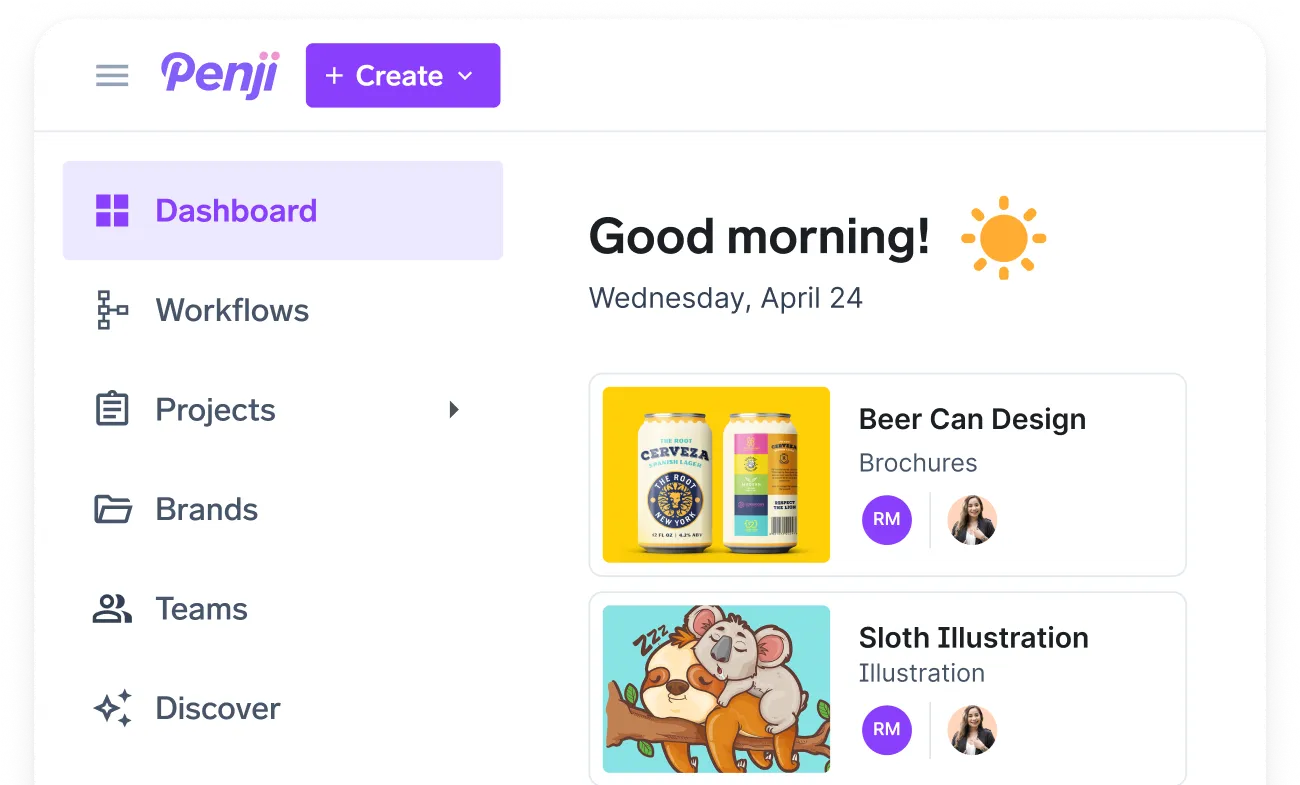![[Fully Managed] Jimi Gibson from Thrive Agency EP 124](https://penji.co/wp-content/uploads/2025/07/BLOG-IMAGE-Jimi-Gibson.jpg)
Shannon: Hello, everyone, and welcome to the Fully Managed by Penji podcast, the podcast where we discuss marketing and business tips to help assist you on your business journey. I’m your host, Shannon, Penji’s Partnership Coordinator, and I’m joined here today with a very special guest, Jimmy Gibson, VP of Thrive. Thank you so much for coming on with me today.
Jimi: Absolutely, Shannon. Excited about our conversation.
Shannon: Yeah, me too. I like that your eyes match your shirt. It seems like at least it could be a trick of the light. Looks great.
Jimi’s Career Journey
Shannon: Well, anyway, could you please tell us a little bit about your work at Thrive and kind of what led you up to this point? I know a lot of marketing positions are not linear. A lot of people get here kind of by accident. So it’d be great to hear your story.
Jimi: Well, I can do the quick flyby. I actually went to school, majored in creative advertising and minored in graphic design and actually started out as a designer. The agency I was working at, I’ve pretty much been in agencies my entire career with a couple of little stints in-house for an e-commerce brand. But I was always asking the owners, why does the client want this project done? And so I guess I asked too many questions and they said, well, why don’t you go ask the client? And so I was always fascinated with why are we creating these visuals and this language to help the client? And so that sort of led me up through the path to creative director.
And then I had the opportunity to actually run an agency and loved meeting with the clients, understanding their business problem, and then working with the team to solve that and get them where they needed to be. I’ve actually been with Thrive four years this month. So excited about that. And strategy has always been part of the creative problem solving that I’ve enjoyed. So kind of the left brain, right brain. You don’t have a strategy, you’re probably going to end up somewhere very expensive and not where you wanted to be. So it’s always good to put some effort on the strategy side at the beginning.
So I actually started the strategy department at Thrive and then an operational role opened up and now I’m the VP of creative services which manages all of the web and the photo and video and organic social and all content and so that sort of expression of the brand.
Shannon: Beautiful. Well, that’s really fun. And that’s nice to be able to grow just because you’re interested in the field. That’s really nice, because I think a lot of people just kind of find their way up because they’ve just been here for so long or whatever it may be. But it’s really cool that you kind of found your way through being interested in just learning more. And that just involved growing.
The Importance of Curiosity
Jimi: Yeah. I think curiosity is always a good trait to have and don’t be afraid to ask questions. And, you know, a lot of people might be scared to ask questions because they feel like, well, somebody is going to think I’m stupid. Well, no, everybody is helpful and if you admit that you want to learn something I’ve always found that people are willing to mentor and come alongside and to show you the ropes. I mean what better compliment than for somebody to say can you help me with this? Who’s going to say no to that?
Shannon: Yeah, no, I definitely appreciate that. I’m sure there’s some buzz kills that aren’t going to call you stupid for asking questions. I definitely appreciate that. I’m a big question asker. I always want to be clear on things too. I’m terrified of misunderstanding something and doing something wrong. That’s my biggest fear in work and anything. So yeah, that’s really nice.
Jimi: You have a little perfectionist in you, I guess.
Shannon: Yeah, I just want to know. I just need everything to be laid out for me so that everything is clear. And, you know, if I’m taking gambles, it’s marketing. That’s kind of what it’s about. But as long as I know that the processes and the procedures are all good and they’re okayed by everyone else, it’s good for me. I can roll with that.
Jimi: Yeah, exactly.
Challenges of Leadership
Shannon: So, okay, since you worked your way up, kind of, what do you think the most difficult part of being in your position now is? And is there anything that you kind of miss from earlier on? Like, say, I don’t know, you have too many responsibilities. You’re like, oh, I wish I could breathe.
Jimi: Well, somebody told me along the way that being a manager is fifty percent doing your work and fifty percent managing personalities and inspiring the team. And I would say that’s probably a little bit off depending on the day. With those percentages, it does take a little bit of people skills. And then I think being intentional about staying close to the work so that everything that you’re doing is not administrative, so that you can sort of keep your ear to the ground. I would say that’s the biggest challenge.
And then just making that known, always trying to be sort of a working manager and lead by example and obviously instilling trust in your team. They want to know, does this person know what they’re talking about? The only way to do that is to stay inquisitive as we talked about before and to keep your hand in it a little bit. So yeah, I would say that’s the big thing. We’re a pretty large agency. I think we’re bigger than about ninety five percent of agencies. And so managing about one hundred and twenty people overall. Obviously, there’s other managers of departments, but yeah, can get a little overwhelming, especially in a fast-paced agency environment.
Shannon: Okay. Is there anything that you miss?
Jimi: No, I think I appreciate everything. I mean, certainly over a career, you have a linear path. And then you mentioned some little zigzags along the way. I think just appreciating all the zigzags, and then appreciating where you are in your career. I don’t think I miss anything. I’ve enjoyed all phases of it.
Shannon: Well, that’s really great. It’s good to not miss anything. That means you’re in the right place. If you do miss something, maybe you need to go back down.
Jimi: Sure.
Managing Full-Service Operations
Shannon: So you guys provide and maybe let me know if I’m off base with this. So you guys provide a lot of services and I don’t always see that with different marketing agencies. I know you’re rather large, so that kind of makes sense. How are you able to balance all of this? Because I know that it’s sometimes difficult. A lot of people narrow their fields a little bit more because they’re making sure that they’re not sacrificing quality or they’re not sacrificing the mentality of their staff. How do you make sure that you’re not spreading yourself too thin?
Jimi: Yeah, great question, Shannon. So we are full service and depending on who you ask, full service can mean a variety of different things. But across the digital spectrum, we don’t do a lot of traditional marketing, so don’t place print ads. We may have a client that asks us to do outdoor or direct mail, but traditionally we are full service digital marketing. So anything related to helping a small to medium sized business or even enterprise level do better through the power of the internet.
And that would include we have in house copywriters, we have in house designers, photography, video, all of the traditional services related to paid media, SEO, organic social, those types of things. I think looking back over the, I think it’s about nineteen years. You don’t start out doing everything and having a large agency. You have to grow at some point.
So there was a purposeful growth pattern around twenty sixteen where we wanted to be able to have a thousand clients on our roster in the next five years from twenty sixteen. We actually beat that by a year, and just being intentional about what services make sense, what are we skilled at. We don’t want to try something out on somebody and then we actually created departments that serve as their own separate P&L so that they have to carry their own weight instead of one department helping another department succeed and carrying the cost of goods associated with that.
And so I think that was a strategic decision that allowed us to make sure there was skill and a market for the service that we were going to launch and then holding that team accountable to various revenue and gross profit goals. And that is a healthy way to do it. And yeah, just making sure that the layers of the team are appropriate for mentorship and management and specialties within those areas. So yeah, I would say that’s the short answer.
Client Communication Strategy
Shannon: Yeah. So could you maybe talk about how you’re able to communicate effectively with customers throughout the process? Because I feel like this is something that everyone kind of does a little bit differently.
Jimi: Yeah. So we did make a radical shift last year and we took all of our clients and divided them up into four teams. It is a matrix organizational structure, which is very common in larger organizations. A lot of consulting firms do a matrix organizational structure. And basically what you’re doing is you’re creating four boutique agencies within a large agency. And then we are able to divide the teams and the staff up appropriately so that we have a closer interaction with clients, and then there’s collaboration among the team members.
So we are a big company, but we have this smaller approach in what we do. Obviously, we have project management software. We do have account managers that have direct contact with the client. We have project managers that help. And then we also make sure that communication is consistent in the way that we communicate, because a lot of times if somebody’s posting on Gchat and somebody else is posting in the project management software and somebody else is sending an email, it can get twisted up pretty fast.
So we actually created about an eighty page document that outlines the procedures on how you communicate. And everybody is tested on that. And it’s kind of the guidebook. And we go, you’re not supposed to communicate that way, communicate this way. And so once those muscles get used to the pathway, it’s pretty easy. And of course, onboarding new customers and new employees, we take them through the same thing.
We also have an onboarding team, which I think is different than a lot of agencies. So we really handhold the process from prospect to client to acquisition to onboarding. And then there’s a kickoff call. And so the client meets everybody. And then we have a pretty clear way in which we lay out the services. We’ve developed what we call the Thrive Score, where we basically analyze the client on two hundred and fifteen data points. And depending on their goals, we carry that score through the onboarding and then into their first three months with us. And then we have quarterly business updates.
And so you talked about communication, keeping everybody on track. We have very specific KPIs that we make sure that everybody on the team knows, what do I do every day for this client? Well, it’s pretty much laid out in a plan. And then the way in which we show up and do our work is consistent. And so, yeah, I would say we have, we’ve sort of honed that in. And then with the shift to this matrix organizational structure, it feels much more manageable. And everybody loves the collaboration from the client side, as well as internal teams.
Shannon: How did you come up with an eighty page document for communication? This is like an incredible feat.
Jimi: Well, you know, a lot of screen grabs, too. So it’s not one hundred percent text. But, you know, it basically walks through each area of communication. And so once you break it down into chapters, it’s not that overwhelming.
Shannon: Seems overwhelming. I was going to say, how do you test people on this? This is like standardized testing. It’s taking me back.
Jimi: Well, we actually have an internal LMS where people go through videos and it’s broken down into modules, just like you might learn a course online or something like that.
Shannon: Okay, that seems less daunting. Yes, yes. The 80 page document was a little frightening. I mean, frightening for the person that compiled that, too good for them.
Jimi: Oh, well, no, we had just the right person compiling it. So get everybody in their sweet spot. Appreciate them. They’re doing a great job.
Shannon: That’s a lot.
Driven by Relationships and Results
Shannon: So the tagline of your agency is driven by relationships and results, correct? Can you share more on the strategy as a whole?
Jimi: Sure. So I’m sure we’re all familiar with a great relationship with a client and making sure you are attuned to their needs, you’re looking around corners for them, you are aware of any personal activities in their life, celebrations, you know, those types of things. That’s only going to last so long if you’re not getting the results for the client. Right. So you can really enjoy the relationship with somebody. But if it’s not a good return on that investment, it’s probably not going to be a long term relationship.
And then on the flip side of that, if you’re really, really good at what you do, but you’re just horrible to get along with and nobody ever wants to meet with you, then that’s not going to last very long. Right. Because we all want to work with people that we like and for it to be an enjoyable experience. So we’re always walking that line of neither one of them going in the ditch. And so we say that the relationship is on one ditch and the results is on the other ditch. And it’s never like you’re never straight and narrow on the road. You’re always kind of going back and forth, but you never want to get in one ditch or the other. So that’s the visual that we like to use.
Shannon: Yeah, I think that’s really important. Obviously, results, I think, is what everyone’s focusing on as the number one. But I think the relationship is just as important because you get out, you do a great job. And then someone hated the experience. And you know, they’re not going to leave happy whether they got the results they wanted or not. And that’s not great for you for multiple reasons. One referrals, you love those agencies depend on referrals and you know, you’re not going to get that if someone didn’t like their experience throughout the process. And you’re not gonna have a long-term relationship with them in the way of like, they’re not gonna come back.
Jimi: We use a lot of restaurant analogies at Thrive. And so I think that fits, you can go to a restaurant and have really awesome meal but the waitstaff was horrendous and the place wasn’t very clean and you’re probably not going to go back. On the flip side of that you can go to another restaurant and they’re very nice and it’s very clean and the food is horrible. So you know you gotta make sure you have the balance.
Shannon: No, that is a perfect analogy because I have been in those situations. I went to, I would visit my parents in North Carolina. I would go to this restaurant with them consistently. And then one day there were roaches in the bathroom and we were like, we can’t go back here ever again. We’ve been eating here for so long. It was so terrifying. It really changes your experience. You know, you don’t want to find roaches in the bathroom of the agency you’re working for, you know, or you’re working with. One bad experience to really put you in. For three strikes. Now it’s maybe you get one strike.
Jimi: Yeah, I am. Something as scary as roaches in a bathroom really gets you. But the restaurant analogies I think are really great. My boss really likes to make analogies, agency analogies to life in general. He loves dating analogies specifically come up often, which is so funny. But yeah, it works. It makes sense. And you can kind of relate agency life to regular life in a lot of manners.
Quick Fire Questions
Shannon: So we’re going to switch it up a little bit. We’re going to have a little game in the middle and then we’ll get back to it because you know, you got to keep you on your toes here.
Jimi: Okay. I’m on my toes. I’m ready for you, Shannon.
Shannon: Okay. These aren’t anything scary. Actually, this is a quiz. You’re being tested on this and we’ll be great at the end. Alrighty. If you were given the option, would you rather work for Google or Microsoft?
Jimi: Oh, I’m just going off personality. I’d say Google. Just cause you’ve seen probably there. It just seems more fun. You know, Microsoft, and it’s probably not fair, has got a little more stiff. But I did see that Microsoft brokered a deal with a nuclear reactor on Three Mile Island to power their AI engine. So that’d be interesting to see.
Shannon: That’s interesting. And thank you. I love learning facts. Super interesting. Okay. Well, I’ll be looking that up after this. If you could only pick one in this scenario, you can only choose one. Would you rather make a client happy or your staff happy?
Jimi: We always say the client comes first, right? Yeah. But if you’re in the long game, you have to rely on your team and you have to respect your team and you have to have their back. And so in my head, I’m going through some scenarios where we had clients that were disrespectful to our team. And so we can either choose to have that be okay or to make sure the client understands that’s not okay. And we’ve got our team’s back. So that’s kind of the scenario that I’m thinking through in my mind. It’s really tough to get awesome people. And I’m not saying it’s easy to get great clients. But from a business perspective, investing in your team to me is the right way to go.
Shannon: Yeah, I would probably agree with that. There wasn’t a right answer, but…
Jimi: Well, you know, you’ve got more justification than you probably were looking for.
Shannon: No, no, no. That’s exactly… That’s how I would think about it too, because I think that, you know, I guess if you don’t have a great team and you can’t trust them, then okay, like client, I guess. I don’t know. But yeah, I think that you should have your team’s back. And if the choice is to make a client or the team happy, I feel like if you like your team nine out of ten times, it’s probably the client that’s not being great or a good sport or whatever it may be.
Jimi: Well, there’s a lot of gray area in there. Exactly. If the team is not doing a great job, then you got to deal with that. It’s a separate issue.
Shannon: Yeah, exactly. So, bad press or no press at all? What’s worse?
Jimi: Well, I’m kind of a brand geek. And I would say in this day and age, it used to be bad press. There’s no such thing as bad press. But I would say no press at all, because then you have the opportunity to tell the story you want to tell from your perspective instead of trying to defend bad press. Or, you know, if the bad press is warranted, you better go fix something.
Shannon: Yeah. Yeah, I think that one’s hard because sometimes bad press leads to good things.
Jimi: Oh, yeah. Yeah, that’s true. But reviews are very important now.
Shannon: Yes, absolutely. And escaping a bad review is very difficult.
Jimi: It is. Especially if you blow up on the internet. Yeah. And then you can never escape. You’ve gone viral, man. That is not always what everyone wants to do.
Shannon: Okay, this one isn’t related at all, but I heard it the other day and I just was curious. I have been asking everyone this question. It’s disturbing. If you were to choose between being sticky or itchy the rest of your life. Which one would you pick?
Jimi: Oh, wow. I would have to go with sticky. I cannot stand to be itchy. And you’re bringing back a horrible memory when I was in high school and I got sunburn on my back and it was the most itchy experience. I was enraged. And so that is not how I want to spend the rest of my life. I’ll just have to be sticky.
Shannon: I’m glad you didn’t say stinky. That would be different.
Jimi: Stinky. Yeah. That’s sticky. I feel like it’s also other people’s problem though. That’s the only thing. Right. Yeah. So that it’s a hard one. I don’t really know what I could pick. I still haven’t been able to choose. That’s why I keep asking people.
Shannon: Yeah. Well, that’s all of our fun for today. Now we have, now I’ll ask you questions again. We’ll go back to the gauntlet.
Jimi: You did. You did. I don’t know about the sticky, itchy question. You know, I’ll get back to you on that, but I’m going to have nightmares. Every time I think of sunburn, I think of my mom telling me the story about when, how she was a teenager, but one of her friends’ boyfriends fell asleep with his hand on his girlfriend’s back. And he, she had a handprint on her. I think that’s horrible. I think about that a lot. I’m always like conscious of it. If I’m ever at the beach, like, oh, I can’t like I have to my side.
Knowing When to Say No to Clients
Shannon: All right. So we’ll get back to the thick of it. How do you know when to say no to a client?
Jimi: Wow. So we don’t have eighty pages, but we do have a checklist. One of the big ones that we have at Thrive is the grandma rule. And so if we don’t feel comfortable telling our grandma about what the client does, then we don’t take the client. So that’s our biggie, the grandma rule. And so sometimes there’s discussions about, well, my grandma’s cooler than your grandma. Maybe she wouldn’t think that’s so bad. But yeah, I would say one of the things we talked about before is being disrespectful, unrealistic expectations based on where the client is in their life cycle. Yeah, I would say those are probably common, but the grandma one always rises to the top.
Shannon: I actually really like that. I’ve never heard of that before. It’s interesting, too, because of the amount of industries. My favorite question to ask on this is what’s the most unusual client you’ve ever worked for? I guess the industry that the client’s in. And those are always things that you probably wouldn’t want to tell your grandma about. Because they come up a lot. It’s the same industry, too, that consistently keeps coming up when I ask that question. And I’m like, oh, you can probably guess. You can probably guess what it is. But, yeah, so that’s funny. And I guess I know, you know, everyone needs marketing. Right. But it’s very, very funny.
The Importance of Websites
Shannon: So how important do you think a website is in getting a sale for a company? So as an agency or a client?
Jimi: Well, I always say that the website is the hub of all activities related to digital information. And so I get frustrated when I go looking for a service provider and their website is a social platform. I think that’s common these days but you don’t really have control over that social platform and so I would say investment in a website even if it’s just a landing page is sort of the minimum requirement for doing business because you have control over what you say on that, where you update it, what images show up, all of those types of things. So I would say non negotiable.
Shannon: Okay, I would agree, I would tend to agree. But okay, so do you think that, what do you think is more important content, or design for a website? If you had to say you had to sacrifice one for the other, or you had to want to be less quality if you had to be in that position to pick one?
Jimi: Yeah well coming from the design background you would think I would answer design but pretty websites don’t make companies money. Informed prospects knowing whether that site is or whether that company is going to be able to deliver on that promise is more important and I would say even from a search perspective words on the page are going to get you ranking where Images don’t.
Now, obviously they go hand in hand and we’re just sort of being hypothetical here because if you go to a website that looks really bad and it’s just content, then that projects something about the company, right? And then vice versa, if you go to a website that’s just all flash and no substance, then that also says something. But if I had to pick one, I would say content.
Shannon: I would, I don’t know if I would agree. And this is, it’s interesting. So I have found this and I do like to ask this question because I always want to hear people’s opinions and I go on a website and it catches me, like catches my eye. And I think it’s interesting. I will be more likely to go through the website and maybe the content isn’t there. Like it’s somewhat unclear what they do, but I’m more likely to ask a question or email someone because I really liked their website. But on the other side of the coin, if a website is confusing, that’s what makes me mad. It can be unclear and that’s not necessarily confusing. But if I have no idea what you do or what you could give me, then I will just click off the website. I’m not even going to bother to learn more because why that’s the focal point of your business. You should be conveying that.
Jimi: Absolutely. And that’s why we get into conversion rate optimization for clients so they can figure out what is that balance.
Conversion Rate Optimization Deep Dive
Shannon: Can you go into that? So many people may, maybe you’ve heard that term, maybe you haven’t. Some people kind of take the acronym and refer to it as CRO, C-R-O, conversion rate optimization.
Jimi: And really it’s just, so if you look at a website, there’s a three-legged stool. There’s traffic to the website. There’s the value of somebody converting on that website. So whether it’s an e-commerce website where you’re purchasing something or it’s a lead for some sort of service and there’s a value of that service. So there’s a price associated. So traffic to the website, the price. And then the third one is conversion rate. Right.
And so a typical e-commerce brand probably converts at a two to three percent. So every hundred people that visit the site, you’re only going to convert two to three percent. Obviously that fluctuates some can be dramatically less some can be significantly more but I would say most people don’t think about conversion they just want to pour more traffic to the site right and if you just sat down and you looked at five things on your website you’d be doing better than most websites I would say ninety percent.
So maybe everybody sits around if you’re an agency do this with your clients websites if you’re coming from the client perspective, sit down and look at your own website. Are you ignoring the mobile optimization? Are you always looking at your website on one or the other, desktop or mobile or tablet? And so the order in which things appear on the site can dramatically affect conversion. If they don’t stack in the right, you may not want to include everything on a mobile or things loading automatically the right way and in the right order. Like you just said is the narrative clear or is it confusing based on how things are loading? So that’s one. Don’t ignore mobile accounts for sixty plus percent depending on the industry of traffic.
Slow load times. Google is very serious about slow load times in their core web vitals, that’s a key factor. And so how quickly is your website loading? We have an impatient world out there. Nobody waits for the microwave to hit zero, right? We’re always pulling our stuff out of the microwave too soon. So yeah, look at your page load speed. You can just Google page load speed and it’ll test your site and it’ll tell you what’s wrong with it. So that’s another one.
Also cluttered messaging. Don’t be confusing. We always like to say, One reader, one solution, and one offer per page. So just be brutally honest about your website and does it pass that test? One reader, one offer, one solution per page.
And then neglecting user behavior data. I have a lot of quasi experts related to how a website should look what it should do what it should say typically we call this the hippo factor highest paid person’s opinion and they’re not always right. And so you need data. And there’s all sorts of tools out there that can track what’s going on on your website related to heat maps, user data. They’ll record activity on your website. You can hire companies that will actually give people an assignment to go and do things, look at scroll patterns, all those types of things. So don’t neglect user behavior data.
And then don’t overcomplicate your forms. If your website has a form, for every field that you add to your form you drop your conversion about four percent. And you talked about dating analogies earlier, are you asking for too much too soon? Do you lean in for the kiss or the hug and you shouldn’t be doing that right away right? And so if you have a very complicated form you’re creating some friction between you and the person who may be interested, but not really ready to give you all the information that you’re asking for. So those are the five things that we typically start with when we’re talking about looking at your website from a conversion perspective.
Shannon: I think that was incredible. I am going to be honest. That was perfectly laid out. I think that if I just came to you and asked you for a meeting, I’d get so much out of just that chunk of information that you just gave me. I think that also I really resonate with the idea of looking at your website consistently. That’s something that my boss really likes to do. He’ll send it over and over again. We’re constantly changing and modifying it for not only engagement purposes, but obviously the conversions.
And I think that there’s, I think a fresh eye is something that’s really helpful too, because we’re looking at it over and over again. I think he was so excited when I joined on. He’s like, oh, another person to look at the website. But it is when you’re looking at it over and over again, you miss a lot of things because you’re not thinking about it like a client or potential client. You’re thinking about it like this is my baby and it’s perfect because it’s mine. Nobody wants to hear their baby’s ugly. But it sometimes is.
But yeah, no, I think that a website is so unbelievably crucial in order to gain a sale. I mean, what else? Unless someone had heard an amazing review about you outside of ever seeing your website or coming in content, like for just authentic people who had just heard about you coming to it, you really need that push of this is well done and I have respect for you based off of just looking at this one little page.
Jimi: Absolutely. And I think the, you know, the one reader is a tough thing because we want to throw so much on a page. And as somebody who’s looking at that, you really got to know who is your client avatar, what’s in their head, what can you answer for that specific client avatar? Because if you try to answer everything for every version of an avatar you have, they’re just going to get really confused. So some selection process and branching people out to get them to a very personalized conversation about what their needs are is, you know, obviously a strategy. I know y’all do web layouts, and I’m sure that goes into how you work with your clients.
Shannon: Yeah, we have a chat service that they can explain in detail what they would need or want from us. It’s very helpful. We can’t make you happy if you’re not clear about what you want and how we can make you happy. We try to communicate really well with our clients.
Jimmy: That’s really good.
Closing
Shannon: But this is all the time we have today. Unfortunately, this is this is a lovely conversation. Thank you for participating in our game.
Jimi: Absolutely. I appreciate your being a great sport in our experiment.
Shannon: But thank you so much. I really appreciate this. And I learned a lot from this is always my favorite thing to be able to do because I get to learn and know marketing it’s constantly growing and changing and to be able to learn from people like you is absolutely incredible so thank you.
Jimi: Well it was fun Shannon, you made it fun so thank you.
Shannon: I appreciate that thank you so much and to everyone watching and listening at home please don’t forget to like and subscribe to watch more awesome episodes like this and laugh because that’s really important too thank you very much.
About the author
Table of Contents
- Jimi’s Career Journey
- The Importance of Curiosity
- Challenges of Leadership
- Managing Full-Service Operations
- Client Communication Strategy
- Driven by Relationships and Results
- Quick Fire Questions
- Knowing When to Say No to Clients
- The Importance of Websites
- Conversion Rate Optimization Deep Dive
- Closing









